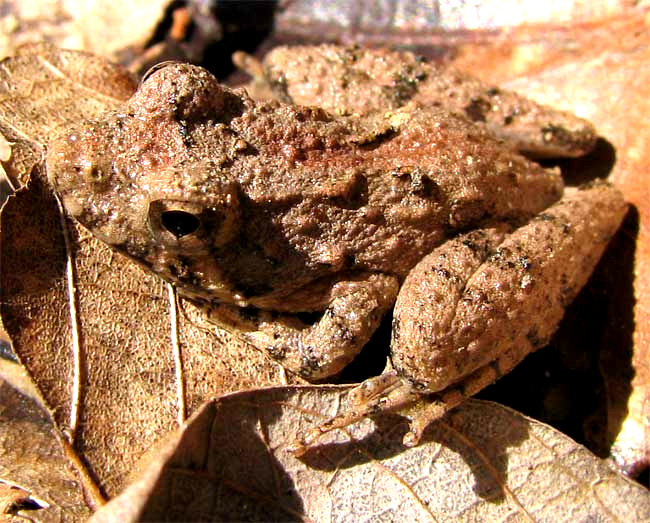Excerpts from Jim Conrad's
Naturalist Newsletter

from the February 16, 2009 Newsletter, issued from the forest near Natchez, Mississippi; elevation ~400ft (120m), ~N31.47°, ~W91.29°:
NORTHERN CRICKET FROG
At the bayou floor's edge, a grayish frog hardly larger than my thumbnail catapulted from beneath my descending foot just in time. It took a while to find his resting spot because he was beautifully camouflaged among dry, brown leaves. When I finally located him he was so warty that I thought he was a baby toad, but soon doubt arose. See what you think; that's him above.
His snout seemed too long and rounded to be a toad's, there were no signs of a toad's parotoid glands behind the eyes, and his middle back toe seemed too long and slender to be a toad's. Eventually it occurred to me that this must be a cricket frog, despite cricket frogs I've known being of different colors, and nearly always showing a nice black triangle atop the head between the eyes. Best I can figure out, the picture shows a Northern Cricket Frog, ACRIS CREPITANS, but it sure is a plain one. The species is famous for its varied coloring and patterning, however. Just in New York six distinct but intergrading color morphs and four pattern morphs have been recognized.
For the last couple of weeks I've been hearing both cricket and chorus frogs calling from a pond below my trailer. Cricket frog calls sound like small metal balls being clicked together very fast. There's more about Northern Cricket Frogs, including their distribution map and a link for hearing them on AmphibiaWeb.Org's Acris cepitans page.
Cricket frogs are members of the Treefrog Family, even though they aren't arboreal and their toe tips lack the roundish adhesive pads of other treefrogs.
Northern Cricket Frog populations have suffered greatly during recent years, mostly from pesticides, fertilizers and habitat destruction. Though I remember them as abundant when I was a child in Kentucky, now Acris crepitans is listed as Endangered in Minnesota, Wisconsin and Ontario, Threatened in New York, and as a Species of Special Concern in Indiana, Michigan, and West Virginia.